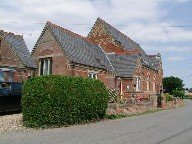| |
|
| |
|
The
first Methodist church at Tattingstone was
erected in 1801, for a Wesleyan Society which had
been registered in 1797. This is roughly the same
date as a Wesleyan Society was formed in
neighbouring Brantham, but while the Society
there does not appear to have built a proper
chapel until as late as the 1960s, the Methodists
of Tattingstone seem to have been a more
energetic lot.
| The 1801 chapel was replaced
in 1842 by a structure which seated more
than 200 people, and Ebenezer Moulton,
the Wesleyan minister at the the time of
the 1851 census of religious worship,
claimed that it was filled every Sunday.
His Anglican counterpart in Tattingstone,
Charles Boileau Elliot, bemoaned the fact
that a third of the population of the
parish were dissenters, and barely a
hundred people attended service at the
parish church. In fact, given that this
was a parish of just 426 people, meaning
that three-quarters of the parish were
going to church on a Sunday, these were
both good attendances, and a remarkably
high proportion for Suffolk. It
was probably this success which justified
the building, in 1877, of this grand
structure in polychromatic brick out on
the road to Bentley. But these were the
harvest years for the Methodists, and
attendances would go into a steep decline
through the 20th Century. The Methodist
church at East Bergholt closed in 1982,
and this one followed in 1988. It has
been subdivided into several private
houses. Only the 1961 Methodist chapel at
Brantham now survives as a reminder of
the popular dissent of this area's
agricultural labourers.
|
|
 |
|
|
|
Simon Knott, October 2009
Amazon commission helps cover the running costs of this
site.
|
|
|

